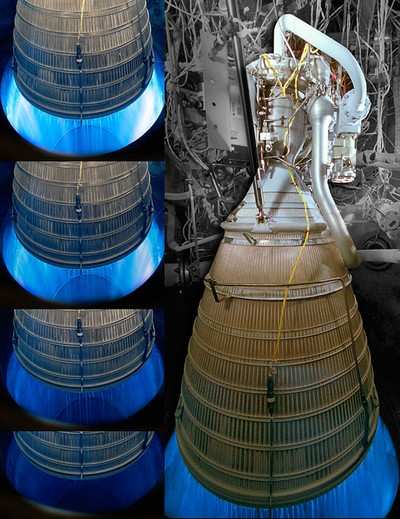CECE Throttleable Rocket Engine
NASA tells ANN a liquid oxygen-hydrogen pump fed engine,
developed to demonstrate advanced rocket technologies for future
space vehicles, achieved a major technical milestone recently in
throttling capability. The engine was designed to demonstrate
successful throttling from full power down to 10 percent of its
thrust. This flexibility to control the flow of fuel through an
engine is necessary for a lunar lander, allowing the spacecraft
ample propulsion, yet enough control to land gently on the moon's
surface.

The Common Extensible Cryogenic Engine -- CECE for short -- was
built off the design of the Pratt & Whitney Rocketdyne RL10
engine. which has a proven history of performance. CECE is fueled
by a mixture of liquid oxygen and liquid hydrogen and generates
13,800 pounds of thrust.
Using liquid hydrogen and oxygen in rockets will provide major
advantages for landing astronauts on the moon. Hydrogen is very
light but has about 40 percent more performance (force on the
rocket per pound of propellant) than other rocket fuels, enabling
lower vehicle mass and a larger payload than with the same amount
of conventional propellants.
"This technology has the potential to be the backbone of a
deep-throttling, reliable, reusable engine for use across most
human and robotic missions," said Tony Kim, NASA's Deep Throttling
Engine Project Manager. "Through two rounds of testing, the CECE
team has accomplished quite a bit, but we still have a long way to
go before this technology will be ready for full scale
development."
Engineers have added throttling ability by using a bypass valve
to direct hydrogen around the turbopump that drives propellant into
the combustion chamber. Through two rounds of hot-fire testing, the
CECE team has demonstrated throttling operability to 9.5 percent
power, but operation with stable combustion to 20 percent power, or
a 5-to-1 throttling ratio. Engine performance data collected during
2098 seconds of hot run time will be analyzed to support future
development decisions.
Looking forward, the team will push CECE to lower throttle
levels. Currently, at lower throttle levels, oxygen vapor forms on
the inner injector plate and causes the oxygen flow to fluctuate.
This triggers pressure oscillations in the engine called
"chugging."
 Chugging may not be a problem for
the engine itself, but the vibrations it causes has the potential
to resonate with the structure of the rocket and could cause
damage. The next tests will determine whether, with modifications
to the injector and valves, CECE can demonstrate stable combustion
down to 10 percent power, a 10-to-1 throttle ratio.
Chugging may not be a problem for
the engine itself, but the vibrations it causes has the potential
to resonate with the structure of the rocket and could cause
damage. The next tests will determine whether, with modifications
to the injector and valves, CECE can demonstrate stable combustion
down to 10 percent power, a 10-to-1 throttle ratio.
The CECE collaboration includes engineers from Marshall Space
Flight Center and Glenn Research Center joined with Pratt &
Whitney Rocketdyne.
NASA has invested in CECE technology since 2005. The aim is to
achieve a more reliable, robust and less expensive rocket engine
ready in 2018 for America's next moon landing.
"This CECE testing has moved us another step closer in providing
risk mitigation for designing and building a future lunar lander,"
said Mark Klem, NASA's PCAD Project Manager.
 ANN's Daily Aero-Term (04.25.24): Airport Rotating Beacon
ANN's Daily Aero-Term (04.25.24): Airport Rotating Beacon ANN's Daily Aero-Linx (04.25.24)
ANN's Daily Aero-Linx (04.25.24) Klyde Morris (04.22.24)
Klyde Morris (04.22.24) Airborne 04.24.24: INTEGRAL E, Elixir USA, M700 RVSM
Airborne 04.24.24: INTEGRAL E, Elixir USA, M700 RVSM Airborne 04.22.24: Rotor X Worsens, Airport Fees 4 FNB?, USMC Drone Pilot
Airborne 04.22.24: Rotor X Worsens, Airport Fees 4 FNB?, USMC Drone Pilot




